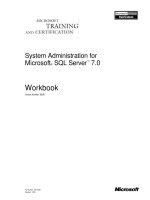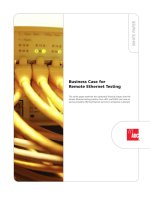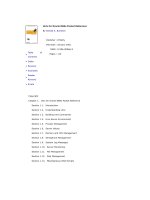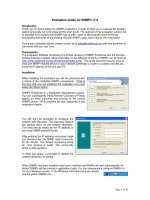Tài liệu New Life for VoIP doc
Bạn đang xem bản rút gọn của tài liệu. Xem và tải ngay bản đầy đủ của tài liệu tại đây (100.48 KB, 4 trang )
white paper
Power Over Ethernet:
Final approval of the Power over Ethernet (PoE) standard in June, 2003 removed a
significant barrier to widespread adoption of IP telephony. The standard, IEEE 802.3af,
specifies how to supply power to compliant devices over Ethernet LAN cabling. Armed
with uninterruptible power supplies (UPS), IT staff can now deploy Voice over IP (VoIP)
telephones without worrying about them not functioning during a power outage. This,
of course, is a well-tested idea. Public telephone companies have been using a similar
strategy for over a century to ensure reliable service to their customers.
The benefits of this enabling technology are not limited to IP telephony, however. Many
applications that deploy equipment with low power requirements in areas that aren’t
already wired for power will benefit from reduced cabling costs. A single standard
Ethernet cable will now be able to provide both power and communication services to
wireless network access points, IP cameras, security badge readers, and many other
devices. A list of the advantages PoE confers includes:
• Reduced cabling costs. One set of wires provides both power and data.
• Reliability. A UPS at the power distribution source can guarantee power
to all connected devices.
• A worldwide power standard—the first. This means that PoE devices
will plug in anywhere.
• SNMP network management. This system can be used to monitor and control
connected devices, including resetting them and shutting them down remotely.
• Simplification of wireless LAN installation. Access points can be moved
and wired in easily.
Technology Overview
The 802.3af standard defines two new hardware components. The first, power sourcing
equipment (PSE), is responsible for supplying up to 15.4 watts of power (at 48 volts) to
the second, called the powered device or PD. The two types of PSEs, DTE and midspan
PSEs (also called midspan controllers), are discussed below.
New Life for VoIP
2
DTE PSEs
DTE PSEs are PoE-compliant Ethernet switches and are sometimes called end-span PSEs. They use
pins 1/2 and 3/6 of the eight-pin Ethernet cable for both data and power. This powering scheme
is sometimes called Alternative A (Figure 1). Note that pairs 1/2 and 3/6 can be of either polarity.
Figure 1. Alternative A
Midspan Controllers
Midspan controllers, like the ADC Midspan PoE Controller Panel (see page 4), are used on LANs
that don’t have PoE-compliant switches. Sometimes called midspan injectors, these devices stand
between a legacy Ethernet switch and a PD and supply the PD with power (Figure 2). These
devices use a powering scheme called Alternative B, which means they use pairs 4/5 and 7/8
(Figure 3). Again pairs 4/5 and 7/8 can be of either polarity. Midspan controllers cannot be used
on 1000Base-T LANs.
Figure 2. Midspan Controller Configuration
UPS
Midspan Power over
Ethernet Controller
Ethernet
Switch
VoIP Phone
Wireless LAN
Access Point
Network
Camera
3
Figure 3. Alternative B
Powered Equipment (PD)
Because DTE PSEs and Midspan PSEs place power on different pins, the 802.3af standard
requires that powered equipment be engineered to accept power from either alternative. To
power non-compliant equipment, devices called splitters can be installed. Splitters separate
the DC voltage and data into different outputs that the non-compliant device can use.
Detection of Compliant Devices
To avoid damaging devices that aren’t PoE compliant, the standard specifies a method of
detecting PoE compliance before significant voltage is placed on the cable. It works like this:
The PSE applies a small current-limited voltage to check for the presence of a 25k ohm
impedance in the PD. Only if the PSE detects this impedance is the full 48V applied.
Limitations
The standard specifies that the current delivered to each PD be limited to 350 milliamps and
the total continuous power to 12.95 watts—factoring in power loss over the cable. This is
insufficient for power-hungry equipment, such as servers, printers, and routers.
Buyer Beware
Prior to the finalization of 802.3af, aggressive vendors were developing PoE products based
on where they thought the standard was heading. Because of some last minute changes to
the specification, these products may not be in compliance. Buyers will have to make their
own judgments regarding these premature offerings. Products developed after the June 2003
approval of 802.3af, however, are likely to comply.
ADC Midspan Controller Panel
Figure 4. ADC Midspan Controller Panel
The ADC Midspan Controller Panel is a rack mounted, fully 802.3af compliant midspan PSE that can
power between 1 and 24 PoE devices. It offers the flexibility of universal input power (115/230VAC,
50/60Hz) and multiple configurations.
Configuration Optional SNMP Module
24-Port Modules Yes
16-Port Modules Yes
8-Port Module Yes
Table 1: Midspan Controller Panel Configurations
The Midspan Controller Panel’s powerful management features include:
• Front panel LEDs that display information on individual port detection and powering
• An optional CPU module that enables SNMP management and complies with RFC3621
• Management control of up to five chassis using a single IP address
ADC Telecommunications, Inc., P.O. Box 1101, Minneapolis, Minnesota USA 55440-1101
Specifications published here are current as of the date of publication of this document. Because we are continuously improving our products, ADC
reserves the right to change specifications without prior notice. At any time, you may verify product specifications by contacting our headquarters
office in Minneapolis. ADC Telecommunications, Inc. views its patent portfolio as an important corporate asset and vigorously enforces its patents.
Products or features contained herein may be covered by one or more U.S. or foreign patents. An Equal Opportunity Employer
1290249 4/04 Original © 2004 ADC Telecommunications, Inc. All Rights Reserved
Web Site: www.adc.com
From North America, Call Toll Free: 1-800-366-3891 • Outside of North America: +1-952-938-8080 Fax: +1-952-917-3237
For a listing of ADC’s global sales office locations, please refer to our web site.









